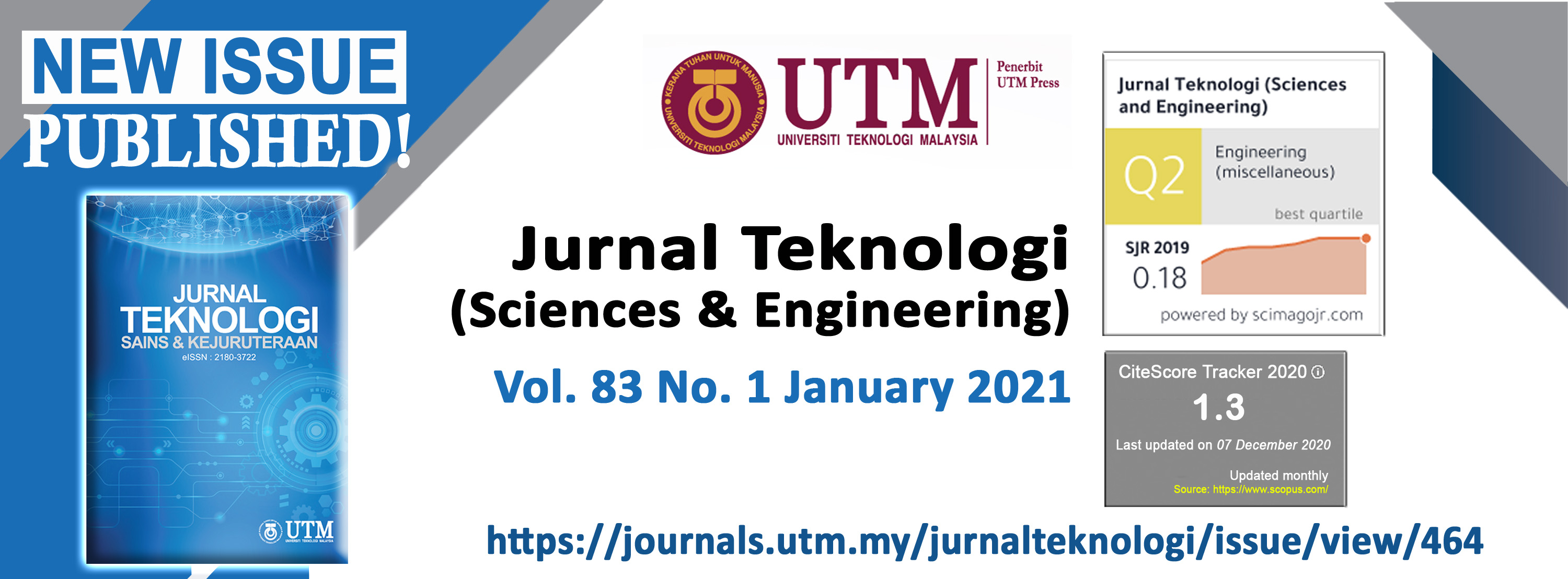OPTIMIZATION OF REFLUX EXTRACTION FOR CAESALPINIA SAPPAN LINN. WOOD BY USING RESPONSE SURFACE METHODOLOGY
DOI:
https://doi.org/10.11113/jurnalteknologi.v83.14590Keywords:
Caesalpinia Sappan Linn., Responce Surface Methodology, Reflux extraction, UV-vis spectrophotometer, OptimizationAbstract
Caesalpinia sappan linn. (CSL) is a plant which is also known as Sepang tree contains various medicinal values such as to treat diarrhea, skin rashes, syphilis, jaundice, drinking water for blood purifying, diabetes, and to improve skin complexion. The aim of this study is to obtain the most optimum condition in terms of the ratio of sample to solvent, particle size, and extraction time to get the highest amount of concentration of the CSL extract. In this study, the ranges of each parameters used were: ratio sample to solvent: 1.0:20, 1.5:20, 2.0:20, 2.5:20, 3.0:20, particle size: 1 mm, 500 um, 250 um, 125 um, 63 um, and extraction time: 1 hr, 2 hr, 3 hr, 4 hr, 5 hr. The concentration was analyzed using a UV-vis spectrophotometer. The optimum conditions were obtained by response surface methodology. From the design, 20 samples were run throughout this experiment. The optimized value from the RSM were 2.0:20 for ratio sample to solvent, 125 µm of particle size and 2.48 hours with the concentration of 37.1184 ppm. The accuracy of the predictive model was validated with 2 repeated runs and the mean percentage error was less than 3%. This confirmed the model’s capability for optimizing the conditions for the reflux extraction of CSL’s wood.
References
S. Badami, S. Moorkoth, and B. Suresh, “Caesalpinia Sappan A Medical and Dye Yielding Plant,†Nat. Prod. Radiance, vol. 3, no. 2, pp. 75–82, 2004.
N. P. Nirmal, M. S. Rajput, R. G. S. V. Prasad, and M. Ahmad, “Brazilin from Caesalpinia sappan heartwood and its pharmacological activities: A review,†Asian Pac. J. Trop. Med., vol. 8, no. 6, pp. 421–430, 2015.
D. K. Lee, D. H. Cho, J. H. Lee, and H. Y. Shin, “Fabrication of nontoxic natural dye from sappan wood,†Korean J. Chem. Eng., vol. 25, no. 2, pp. 354–358, 2008.
M. Shahril, “OPTIMIZATION OF HYDRO DISTILLATION CONDITIONS FOR THE PRODUCTION OF ESSENTIAL OIL FROM Alpinia galanga,†University College of Engineering & Technology Malaysia, 2006.
B. Kaufmann and P. Christen, “Recent extraction techniques for natural products: Microwave-assisted extraction and pressurised solvent extraction,†Phytochem. Anal., vol. 13, no. 2, pp. 105–113, 2002.
A. Nn, “A Review on the Extraction Methods Use in Medicinal Plants, Principle, Strength and Limitation,†Med. Aromat. Plants, vol. 04, no. 03, pp. 3–8, 2015.
B. S. Larsen, M. A. Kaiser, M. Botelho, G. R. Wooler, and L. W. Buxton, “Comparison of pressurized solvent and reflux extraction methods for the determination of perfluorooctanoic acid in polytetrafluoroethylene polymers using LC-MS-MS,†Analyst, vol. 130, no. 1, pp. 59–62, 2005.
M. Ariff and N. Abdullah, “Optimization of reflux extraction for cat’s whiskers leaves extract using response surface methodology,†Chem. Ind. Chem. Eng. Q., no. 00, pp. 24–24, 2019.
L. S. Chua, N. A. Latiff, and M. Mohamad, “Reflux extraction and cleanup process by column chromatography for high yield of andrographolide enriched extract,†J. Appl. Res. Med. Aromat. Plants, vol. 3, no. 2, pp. 64–70, 2016.
P. Arulpriya and P. Lalitha, “Evaluation of different extraction methods for optimization of extraction of aerial roots of Rhaphidophora aurea entwined over two diverse host trees,†Int. J. ChemTech Res., vol. 5, no. 5, pp. 2173–2176, 2013.
A. Hijazi, D. S. Al Masri, H. Farhan, M. Nasser, and H. Annan, “Effect of Different Ethanol Concentrations , Using Different Extraction Techniques , on the Antioxidant Capacity of Lebanese Eryngium creticum,†J. Pharm. Chem. Biol. Sci., vol. 3, no. August, pp. 262–271, 2015.
S. Christudas, T. M. Kulathivel, and P. Agastian, “Phytochemical and antibacterial studies of leaves of Tridax procumbens L.,†Asian Pac. J. Trop. Biomed., vol. 2, no. 1 SUPPL., pp. S159–S161, 2012.
R. Tabaraki and A. Nateghi, “Optimization of ultrasonic-assisted extraction of natural antioxidants from rice bran using response surface methodology,†Ultrason. Sonochem., vol. 18, no. 6, pp. 1279–1286, 2011.
T. Rakić, I. Kasagić-Vujanović, M. Jovanović, B. JanÄić-Stojanović, and D. Ivanović, “Comparison of Full Factorial Design, Central Composite Design, and Box-Behnken Design in Chromatographic Method Development for the Determination of Fluconazole and Its Impurities,†Anal. Lett., vol. 47, no. 8, pp. 1334–1347, 2014.
B. K. M. Demirel, “Application of response surface methodology and central composite design for the optimization of textile dye degradation by wet air oxidation,†Demirel Kayan Int. J. Ind. Chem., vol. 3, no. 24, pp. 1–10, 2012.
Z. Chen et al., “UV-vis Spectroscopy,†Photocelectrochemical Water Splitting. p. 126, 2013.
A. Cioabla, “UV-vis Spectrophotometry: Principle and Applications,†no. September, 2013.
A. Ghasemzadeh and H. Z. E. Jaafar, “Optimization of Reflux Conditions for Total Flavonoid and Total Phenolic Extraction and Enhanced Antioxidant Capacity in Pandan (Pandanus amaryllifolius Roxb.) Using Response Surface Methodology,†Sci. World J., vol. 2014, 2014.
R. K. Salar, S. S. Purewal, and M. S. Bhatti, “Optimization of extraction conditions and enhancement of phenolic content and antioxidant activity of pearl millet fermented with Aspergillus awamori MTCC-548,†Resour. Technol., vol. 2, no. 3, pp. 148–157, 2016.
I. Soraya et al., “Effects of temperature , time , and solvent ratio on the extraction of phenolic compounds and the anti ‑ radical activity of Clinacanthus nutans Lindau leaves by response surface methodology,†Chem. Cent. J., pp. 1–11, 2017.
S. Wang et al., “Optimisation of the ethanol-based heat reflux extraction of isoflavones from Pueraria lobata ( Willd .) Ohwi root,†vol. 959, pp. 180–186, 2014.
S. A. Makanjuola, “Influence of particle size and extraction solvent on antioxidant properties of extracts of tea , ginger , and tea – ginger blend,†no. May, pp. 1–7, 2017.
Downloads
Published
Issue
Section
License
Copyright of articles that appear in Jurnal Teknologi belongs exclusively to Penerbit Universiti Teknologi Malaysia (Penerbit UTM Press). This copyright covers the rights to reproduce the article, including reprints, electronic reproductions, or any other reproductions of similar nature.
















